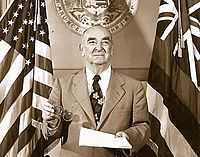Samuel Wilder King
| Samuel Wilder King | |
|---|---|
 | |
| 11th Territorial Governor of Hawaii | |
| In office February 28, 1953 – July 26, 1957 | |
| Appointed by | Dwight D. Eisenhower |
| Preceded by | Oren E. Long |
| Succeeded by | William F. Quinn |
| Delegate to U.S. House of Representatives from Territory of Hawaii's At-large district | |
| In office January 3, 1935 – January 3, 1943 | |
| Preceded by | Lincoln Loy McCandless |
| Succeeded by | Joseph Rider Farrington |
| Personal details | |
| Born | December 17, 1886 Honolulu, Kingdom of Hawaii |
| Died | March 24, 1959 (aged 72) Honolulu, Territory of Hawaii |
| Political party | Republican |
Samuel Wilder King (December 17, 1886 – March 24, 1959) was the eleventh Territorial Governor of Hawaii and served from 1953 to 1957. He was appointed to the office after the term of Oren E. Long. Previously, King served in the United States House of Representatives as a delegate from the Territory of Hawaii. He was a member of the Republican Party of Hawaii and was the first of native Hawaiian descent to rise to the highest office in the territory.
Education
His father James A. King (1832–1899) was a ship's master for Samuel Gardner Wilder, and later politician in the Republic of Hawaii.[1] His mother was Charlotte Holmes Davis, who descend from Captain William Sumner, who served as a royal pilot under Kamehameha I and his successors, and Oliver Holmes, who served as Governor of Oʻahu under Kamehameha I. King was born December 17, 1886 in Honolulu and was a subject of the Kingdom of Hawai'i. A devout Roman Catholic, King attended Saint Louis School, but graduated from McKinley High School. Upon graduating, King went on to study at the United States Naval Academy in Annapolis, Maryland. He entered the United States Navy as a commissioned officer where he served from 1910 to 1924. At the time of his discharge, he had attained the rank of lieutenant commander. On March 18, 1912 he married Pauline Nawahineokalai Evans, another part-Hawaiian.[2]
Early career
King returned to his hometown in 1925 where he entered the real estate profession. In 1932, he ran for his first public office and served for two years on the Board of Supervisors of Honolulu. In 1934, King was elected to the United States Congress as a delegate. He served in Washington, D.C. from January 1935 to January 1943.[3] With the outbreak of World War II, King resigned from Congress to accept a naval commission to become a commander, then captain. He retired from military service in 1946.
Later career
Once again, King returned to his hometown and was appointed to a sub-cabinet office of the governor's administration. King served in the Emergency Housing Committee for a year. He was then appointed to the Hawaii Statehood Commission in 1947 where he stayed until 1953.[3] President of the United States Dwight D. Eisenhower appointed King to the governorship that year. He served in 'Iolani Palace until his resignation on July 31, 1957. He died in Honolulu March 24, 1959, just before Hawaii achieved statehood. He was buried in the National Memorial Cemetery of the Pacific.
His son Samuel Pailthorpe King (1916–2010) became a lawyer and Federal Judge.[4]
References
- ↑ "King, James A. office record". state archives digital collections. state of Hawaii. Retrieved July 28, 2010.
- ↑ Hawaiʻi State Archives (2006). "Marriages: Oahu (1911-1929)". Ulukau, the Hawaiian Electronic Library. Retrieved December 9, 2010.
- ↑ 3.0 3.1 "King, Samuel Wilder, 1886–1959 office record". state archives digital collections. state of Hawaii. Retrieved July 28, 2010.
- ↑ "Transcript of Long Story Short with Leslie Wilcox". PBS Hawaii. March 4, 2008. Retrieved 2010-03-09.
| United States House of Representatives | ||
|---|---|---|
| Preceded by Lincoln Loy McCandless |
Delegate to the U.S. House of Representatives from Territory of Hawaii's at-large congressional district January 3, 1935 – January 3, 1943 |
Succeeded by Joseph Rider Farrington |
| Political offices | ||
| Preceded by Oren E. Long |
Territorial Governor of Hawaii February 28, 1953 – July 26, 1957 |
Succeeded by William F. Quinn |
| ||||||||||||||||
|

